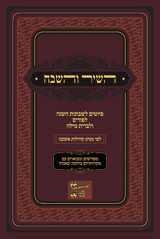20 Elul 5775
השיר והשבח
HaShir vhaShevach (Hebrew)
Piyutim for the Shabbosos of the Year, for Purim, and for Bris Milah
According to the Tradition of Ashkenaz Communities
by Rabbi Moshe Yehuda Rosenwasser
Jerusalem, 5775
540 pages
Distributed in the USA by Biegeleisen. Available in fine Jewish bookstores. Also available from the author, e-mail This email address is being protected from spambots. You need JavaScript enabled to view it., phone +972-2-571-1160 or +1-845-356-0734, or through representatives in several of the Ashkenaz communities:
- Rav David Cohen, Bnei Brak: +972-54-468-4647
- Rav Yitzchok Goldberg, Bnei Brak: +972-52-761-8267
- Rav Yeshayahu Schneller, Jerusalem: +972-50-414-9045
- Rav Aharon Neckameyer, Beitar: +972-52-863-8531
- Rav Zev Donner, Kiryat Sefer: +972-52-767-2867
- K’hal Adath Jeshurun, Monsey, NY
- Ephraim Rosenstock, K’hal Adath Jeshurun, Washington Heights, NY: +1-212-740-4348
Table of Contents | Sample Pages
This long-awaited work on the piyutim of the special shabbosos and Purim was received enthusiastically by leading rabbonim in Eretz Yisrael, the USA and Europe.
Important features of the book include the following:
- The text has been verified based on more than 40 manuscripts, and all of the censors’ changes have been reversed.
- The piyutim are arranged such that the rhyme, the meter, and the names of the paytanim are clearly evident.
- Headings have been added before each piyut and each section within the piyut which briefly explain the contents of the piyut or section.
- The piyutim are explained line-by-line in easy-to-read Lashon haKodesh.
- Underneath the piyutim are explanations of the difficult words and all of the midrashim and sources in Chazal which the paytan wove into his work.
- At the end of the book is a listing of every verse which the paytan used, as well as a section containing the etymologies of uncommon words.
- The book contains an appendix of all the appellations used by the paytanim, and their meanings, indexed by appellation and meaning.
- A preface explains the origins of piyut and the development of Minhag Ashkenaz and Minhag Polin.
- A brief biography of each paytan and a timeline of major events during the paytanic period appears at the end of the book.
In combination with the author's previous work, LHodos ulHallel, all of the special occasions of the year not covered by machzorim have their piyutim included (except for Shabbos Nisuin, which is only rarely practiced in the current era).
“With the help of Hashem Yisborach, we will henceforth be able to observe the tradition of reciting the piyutim, which Ashkenaz communities maintained so diligently, while thoroughly understanding the words of the Rishonim, and with the proper joy of fulfilling a mitzvah.” (from the approbation of one the eminent rabbonim)

